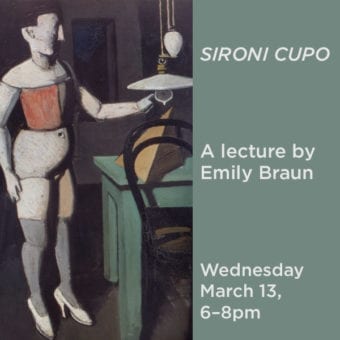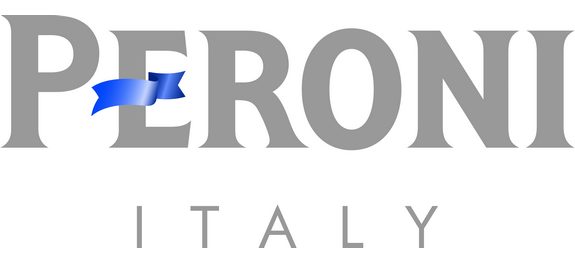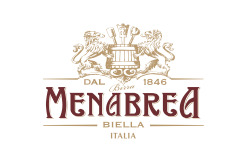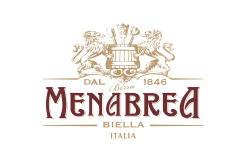The Metafisica Solution: How to Discuss Fascist-Era Architecture Without Controversy
April 26, 2019
As part of the METAPHYSICAL MASTERPIECES STUDY DAYS, CIMA is pleased to welcome Prof. Mia Fuller to present her keynote from 6pm – 7:30pm:
The Metafisica Solution:
How to Discuss Fascist-Era Architecture Without Controversy
The term ‘metaphysical’ associated with the paintings of de Chirico and Carrà has, beyond its origins in the early 20th century, played an epiphenomenal role in post-World War II discussions of fascist-era architecture. Finding the 1934 Rationalist-designed town of Sabaudia too ‘good’ simply to be called ‘fascist,’ in the 1970s intelligentsia figures Pasolini and Moravia whitewashed the regime from it rhetorically, using the term città metafisica to describe the town and thereby placing it in an artificially apolitical zone of architectural history. In my talk I will trace this use of ‘metaphysical’ up through the architectural publications that popularized it through the 2000s, avoiding discussions about political origins and with them, political legacies. I will contextualize my presentation visually through a range of designs created in Italy under fascism, and in the Italian colonies. Finally, I will turn to recent controversies in Italy regarding the continued uses of fascist-era buildings and monuments.
Mia Fuller is an Associate Professor of Italian Studies at the University of California – Berkeley. She is a cultural anthropologist and urban-architectural historian who has published extensively on architecture and city planning in the Italian colonies, winning the International Planning History Society book prize for Moderns Abroad: Architecture, Cities, and Italian Imperialism (published by Routledge in 2007). She has also written on post-Italian Libya; how Eritrea capitalizes on the built environment Italians left behind; and the historiography of Italian architecture and the arts under fascism. Her research has been supported by a Rome Prize, a Fulbright Grant, and Fellowships from the American Council of Learned Societies and the National Endowment for the Humanities, among others.
Professor Fuller is currently in residence at the National Humanities Center working on a book on the force (or lack of force) of old fascist symbols that still exist in Italy, especially in the Pontine Marshes area, where Mussolini’s largest land-reclamation project took place in the 1930s. This is a long-term project involving intermittent ethnographic fieldwork – started twenty years ago – as well as memory studies, the historical sociology of migration, oral history, and theories of monumentality.
Free for students and CIMA members.
RESERVE A SEAT!
Program schedule:
The event is part of the METAPHYSICAL MASTERPIECES STUDY DAYS and will be preceded by a prosecco aperitivo at 5pm. Presentation begins at 6pm, followed by a Q&A.
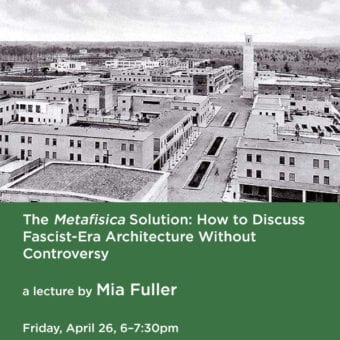
METAPHYSICAL MASTERPIECES STUDY DAYS
April 26, 2019
Day 1: Friday, April 26 (10am – 5pm; prosecco aperitivo; keynote talk at 6pm)
Day 2: Saturday, April 27 (10am – 1pm)
CIMA hosts the Metaphysical Masterpieces Study Days on Friday and Saturday, April 26 and 27, 2019. These annual events offer an opportunity for CIMA’s fellows to share their new research alongside other scholars, in the intimate, collaborative environment of the exhibition space—a rare opportunity to discuss the artists’ career while surrounded by numerous examples of their work.
The Study Days aim to further investigate the major themes of CIMA’s annual installation, as well as to offer new insights into the general debate on Metaphysical Art, in sessions conceived by the 2018–2019 CIMA Fellows following an open call for papers.
RESERVE A SEAT!
FULL PROGRAM SCHEDULE BELOW. For abstracts of the papers and bios of their authors, click here.
*$15 the recommended donation for both days, includes lunch and reception on Friday.
Friday, April 26
10 am – 10.30am
Metaphysical Masterpieces exhibition viewing and registration
Welcome by Emma Lewis, Executive Director of CIMA
10.30am – 1pm
From Collecting to Exhibiting Metaphysical Paintings (Chair: Carlotta Castellani)
Followed by Q&A
Emanuele Greco (University of Florence, Italy): The origins of an ambiguity: considerations on the exhibition strategies of metaphysical painting in the exhibits of the group “Valori Plastici”, 1921-1922
Caterina Caputo (CIMA fellow): Building an Identity for Italian Contemporary Art during the Fascist Ventennio: the case of Rino Valdameri’s Collection
Nicol Mocchi (Soprintendenza, Milan): Metaphysical Art in James Thrall Soby’s travel notebooks
Erica Bernardi (CIMA fellow): “Intellectual lucubrations:” Lamberto Vitali, Giorgio Morandi and Metaphysical art
1pm – 2.30pm
lunch break
2.30 – 5pm
Crossing Borders: Dialogues through Magazines (Chair: Caterina Caputo)
Followed by Q&A
Simona Storchi (University of Leicester, UK): Metaphysical Networks, Metaphysical Writing: Artistic Theorization and Modernist Magazines 1918-1922
Carlotta Castellani (CIMA fellow): The political satire in Italy and in Germany during the Red Biennium: Mario Sironi and George Grosz
Maria Elena Versari (Carnegie Mellon University): “Chiriko wird Akademikprofessor. Expectations, Misunderstandings and Appropriations of Pittura Metafisica in the 1920s European Avant-Garde”
Filippo Bosco (Scuola Normale Superiore, Pisa): «Italienspielerei»: Italian and German painting from metafisica to Magischer Realismus
5 – 6pm
Aperitivo reception
6 – 7.30pm KEYNOTE LECTURE
Mia Fuller (University of Berkeley): The Metafisica Solution: How to Discuss Fascist-Era Architecture Without Controversy
Saturday, April 27
10 am – 10.20am
Metaphysical Masterpieces exhibition viewing and registration
10.20am – 11am SPECIAL PERFORMANCE EVENT
Poetry reading with Italian poet Gabriele Tinti & American actor Vincent Piazza, The nostalgia of the poet, an homage to Giorgio de Chirico
11 am – 1pm
Metaphysical Art and Literature (Chair: Erica Bernardi)
Followed by Q&A
Damian Dombrowski (Julius-Maximilians-Universität Würzburg, Germany): “Sentimento del contrario:” De Chirico’s irony and Pirandello’s “umorismo”
Irena Kossowska (Copernicus University, Torun): In Search for a “New Man”: Bruno Schulz and Giorgio de Chirico
Renato Barilli (University of Bologna): Italian Art in the ’20s and ’70s: Affinities and Differences
Concluding Round Table with CIMA fellows
_______
2 – 6pm
CIMA Special Open Hours for Downtown Culture Walk. Click here for the map!
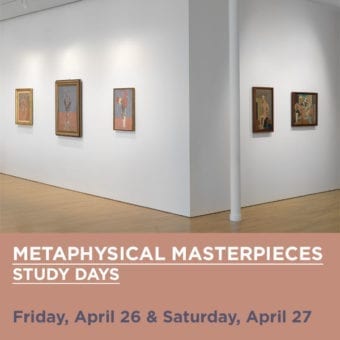
Aperitivo & Drawing Night
April 16, 2019
CIMA opens its unique and intimate setting to artists, students, and others interested in trying their hand at studying works from the Metaphysical Masterpieces exhibition through drawing — interacting with, analyzing, and drawing inspiration from Morandi, Sironi, and Carrà’s art.
Expanding upon the premise that drawing is the most optimal way to apprehend a work of art, this Drawing Night, led by artist Kaitlin McDonough (New York Studio School), will present close-looking and transcription techniques as methods for understanding, empathizing and seeing.
All skill levels welcome!
Limited to 30 participants.
Sold out!
Event Schedule:
6pm – Registration and exhibition viewing
6:10pm – Introduction by Kaitlin McDonough
6:30-7:30pm – Drawing in CIMA’s galleries
7:30pm – Discussion
8pm – Evening concludes
About the artist:
Kaitlin McDonough paints exuberant abstractions, often incorporating objects and nontraditional supports. Equally fascinated by imagery and materiality, her content originates from the sensual inextricability of both. The resulting paintings highlight her interests in performative language, strategy, and energy technology. McDonough received her MFA from Tyler School of Art, Temple University and her BFA from Boston University, Summa cum laude. Prior to being based in New York, Kaitlin lived and worked in Venice, Italy and Rome, Italy where she developed a close relationship with Italian art of the past and present. Her work has been exhibited throughout Italy–in Venice, Rome, Vicenza, Bologna, Verona–and in Boston, New York, Philadelphia, and Serbia. She is the recipient of the Temple University Project Completion Grant and has participated in a residency at the Vermont Studio Center. Kaitlin McDonough is currently the Program Director and member of the Faculty at the New York Studio School of Drawing, Painting and Sculpture where her courses focus on drawing strategies, Color, and Painting on Paper.
*Please note that guests are allowed to bring their own supplies but only sketching materials are permitted. No water media, ink, or solvents are allowed in the galleries.
Pencils and paper have been generously donated by Blick Art Materials. Refreshments have been generously donated by:
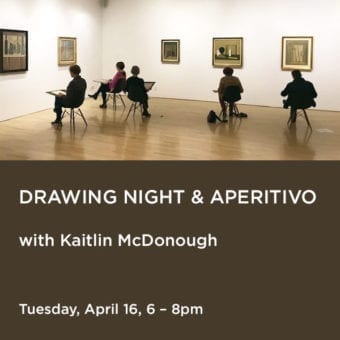
CIMA KIDS! FAMILY PROGRAMS AT THE CENTER FOR ITALIAN MODERN ART
April 13, 2019
The Center for Italian Modern Art is pleased to announce a workshop, for children age 6 -11, led by museum educators and scholars in residence. By incorporating close observation with guided conversation and an artistic activity, children develop meaningful and lasting relationships with art in an intimate exhibition environment.
Children explore the exhibition Metaphysical Masterpieces 1916-1920, Morandi, Sironi and Carrà and discover how Giorgio Morandi sees and interprets ordinary objects of everyday life. Working with crayons, colored pencils and artisanal papers, participants will use their newfound knowledge from the exhibition, to make their own representation around the question: what makes a still life painting, a still life?
(Please note 1 reservation admits an adult and a child)
Schedule
3:30pm — Welcome
3.45pm — Start of the activity: Tour of the exhibition and Workshop with creative activity
5.15pm — End of program
Please note: At least one caretaker must remain at CIMA for the entire duration of the program. While the children are engaged in their creative activity, caretakers are invited to enjoy an Italian coffee, read books from CIMA’s library, peruse newspapers or tour CIMA’s Metaphysical Masterpieces, 1916–1920: Morandi, Sironi, and Carrà exhibition.
Franca Bombieri was born and raised in Italy where she attended the Liceo Artistico (Art School) in Venice. She continued her studies at Ca’ Foscari University, and later received her Bachelors Degree in Liberal Arts with concentration in Art History in New York City. In New York, Franca taught at the Rudolf Steiner School for fifteen years during which she also traveled to Kenya for three consecutive summers to work with the Samburu Tribe, developing a school program that would reflect their culture.
Franca has been able to fuse together her formal education with her experience as a teacher by teaching art classes to children and their care-givers at the Art Barge, the Victor d’Amico Institute of Art in Amagansett NY. Franca’s passion has been finding ways to communicate art to children and teenagers based on cognitive development, as she believes that art is a powerful form of expression that delivers and fosters communication. She has been a volunteer at the Metropolitan Museum of Art in the Access Department of Education for these past five years, and is currently enrolled in the Docent Program.
FAQs:
Can I leave my child?
At least one caretaker must remain at CIMA for the entire duration of the program. We invite you to relax, enjoy an espresso, our exhibition and library during this time.
Will you have programs for other ages?
CIMA is expanding its family programs and will be posting new events and activities for additional age groups.
Please contact info@italianmodernart.org for any further questions.
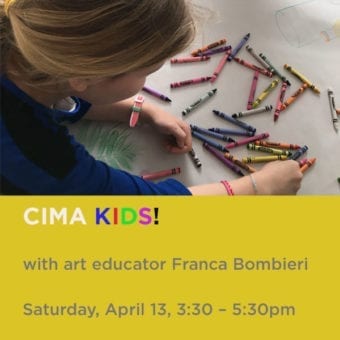
METAPHYSICAL YEARS LECTURE SERIES: ADRIAN LYTTELTON ON 1920
April 10, 2019
The year 1920 marked the turning-point in Italy’s postwar crisis. Left-wing agitation and the threat of revolution reached their climax in September 1920, with the occupation of Italy’s largest factories by the workers. In Turin, Antonio Gramsci emerged as the theorist of the factory council movement as an authentic expression of the revolutionary proletariat. A minority of the Futurists responded by forging links with the Proletkult movement in the Soviet Union. However, Soviet collectivism troubled Marinetti, and many artists, who reasserted the primacy of the individual
However, the failure of the Socialist leadership to seize the occasion to convert their revolutionary rhetoric into action led to profound disillusionment, and to the secession of the left wing of the Socialist party, completed at the Congress of Livorno in January 1921 with the foundation of the Italian Communist party.
The reaction was not long in coming. It started not in the industrial cities but in provincial cities like Bologna and Ferrara, and in their rural hinterland, where the control exercised by the Socialist movement through their organization of agricultural laborers posed an even greater threat to property than the working-class movement in the cities. The reaction took the form of squadrismo: the armed action of the squads organized by the Fascist movement, which won its first symbolic victory with the occupation of the town hall of Bologna, and the expulsion of the newly elected Socialist council. The Fascist movement attracted wide sympathy from those who saw it as a legitimate patriotic response Socialist internationalism and a “defeatist” refusal to celebrate Italy’s victory in 1918. The artist Ottone Rosai was a typical representative of this tendency. However, even as the Fascist movement continued to expand rapidly, some of its original adherents dissociated themselves from it, on the grounds that it no longer represented the cause of “national revolution,” and had become the tool of social reaction.
The rapid political changes of 1920 left many artists perplexed, dissatisfied with the major artistic movements (Futurism or Metafisica) and searching for new directions. Mario Sironi, while refusing any idea of a return to the past, abandoned the optimism of the early Futurists in favor of a stark and pessimistic vision of the new urban reality, while actively contributing as a cartoonist to Mussolini’s Popolo d’Italia. Giorgio Morandi turned away from the public sphere of controversy and sought his inspiration in an intensely private and solitary vision.
Adrian Lyttelton is Professor of History at the Johns Hopkins University Center in Bologna. His previous appointments include Professor of Modern History, University of Reading; Resident Professor of History, Bologna Center; Professor of European History, University of Pisa. He has been Visiting Professor at the University of California, Berkeley and at the American Academy in Rome. He is the author of The Seizure of Power: Fascism in Italy 1919–1929 as well as of many other publications on the Twentieth century Italian and European History.
FREE for CIMA members and students. Registration required.
RESERVE A SEAT!
Program schedule:
6pm – registration, aperitivo, and viewing of Metaphysical Masterpieces
6:15pm – program begins, followed by audience Q&A
8pm – evening concludes
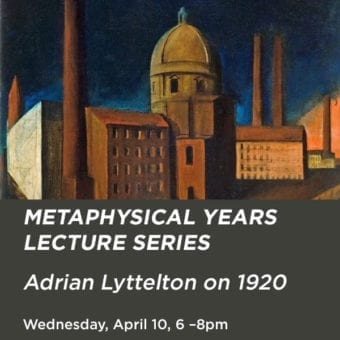
SLOW ART DAY
April 05, 2019
On Saturday, April 6, CIMA will proudly participate for the fifth consecutive year in Slow Art Day! This wonderful initiative was launched in 2008 by the CEO Phil Terry, who, after spending an hour one afternoon observing Hans Hoffman’s Fantasia (1943), developed a new appreciation for closely observing art that he hoped to share with others. Now a global event, its mission is simple: “help more people discover for themselves the joy of looking at and loving art.”
The principle of slow art professes that when all people, regardless of their prior knowledge or expertise, “look slowly at a piece of art they make discoveries” that have the potential to foster profound “passion and creativity.” The slow art approach having been central to our ethos from the start, CIMA always encourages visitors to carry out this active process of observation; however, on Slow Art Day, it will be celebrated.
So on Saturday, April 6, we invite you to slowly experience our current exhibition, Metaphysical Masterpieces 1916–1920: Morandi, Sironi, and Carrà. Visit CIMA during regular open hours (from 1pm to 6pm), challenge yourself to spend 10 minutes in front of one or two of the paintings that most inspire you, and share your distinct insights with us, your friends, or other viewers. You may also join us at 11am or 2pm for espresso and a guided visit of the show – our “slow art”-looking tour led by our fellows in residence.
BOOK YOUR VISIT NOW!
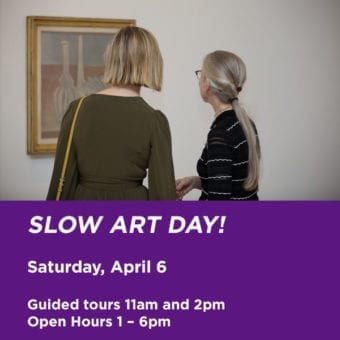
MEMBERS ONLY – CURATOR-LED TOUR OF “LUCIO FONTANA: ON THE THRESHOLD”
April 02, 2019
“In our current climate of huge retrospectives . . . On the Threshold is a necessary – and for those who look closely, rewarding – addendum.” —Wall Street Journal
CIMA Members are invited to join us for a private tour of the exhibition Lucio Fontana: On the Threshold at The Met Breuer. Our tour will be led by Iria Candela, the Estrellita B. Brodsky Curator of Latin American Art in The Met’s Department of Modern and Contemporary Art who has curated the show with the assistance of Aimé Iglesias Lukin, a Research Associate of the Department of Modern and Contemporary Art.
This exhibition reexamines the career of one of the most innovative artists of the twentieth century. The show explores the artistic career of the Argentine-Italian artist Lucio Fontana, widely known for his Cuts series, slashed paintings that became symbols of the postwar era. However, the exhibition explores also the artist’s beginning as a sculptor and, alongside the paintings, sculptures, and drawings on view, the Met will also reconstruct three of Fontana’s late, immersive environments, providing a rare perspective on his pursuit of a spatial and technological art.
Please note: CIMA members will receive an email invitation in our newsletter, via Mailchimp to RSVP for this event. Due to the special nature of this private tour with one of the exhibit’s curators, the event is limited to 20 members only!
The exhibition will be closing on April 14, so seize the chance to experience the show before it is over!
If you are feeling generous and you are able, please consider making a donation in person or here. As a public non-profit organization, CIMA works fervently to make such exclusive and exceptional events available to our members. Any amount will facilitate our ability to continue to offer our members access to one-of-a-kind private events at the premier art institutions across New York City!
Not a CIMA member…? BECOME A MEMBER TODAY!
Members receive free admission to CIMA, access outside of regular public hours, a copy of the annual catalogue, and invitations to exclusive events and receptions.
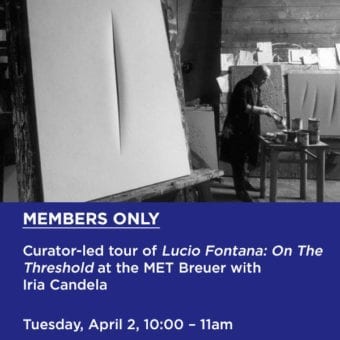
Literary Metaphysics: Massimo Bontempelli and the Foundations of Magical Realism
March 26, 2019
Is there a literary counterpart to what art historians call the ‘Scuola Metafisica’? Giorgio de Chirico himself wrote disquieting poems, dreamlike prose, and even an experimental novel, while his brother Alberto Savinio became one of Italy’s most celebrated modernist authors and was included in André Breton’s foundational anthology of black humor. Another painter, Filippo de Pisis, claimed to have invented ‘Metaphysical narrative’ in Ferrara, and the early work of vanguardists, such as Palazzeschi, Delfini, and Govoni, has often been associated with Metaphysical art. All these experiences contributed to what critics, in textbooks and literary histories, have often called ‘Italian Surrealism.’ While challenging such a Franco-centric and imprecise formula, this lecture focuses on the most original and influential poetics that emerged from the impact of Metaphysical painting on Italy’s literary imagination: the style known as Realismo Magico, or Magismo.
Magic(al) Realism is an extremely broad category in current critical terminology, but few know that one of its earliest uses (arguably the first in the realm of literature) was proposed by writer Massimo Bontempelli to re-found Italian literature in the inter-war period. Bontempelli was deeply influenced by his meeting and collaboration with the de Chirico brothers, and forged a poetics of ‘everyday marvel’ that, after unsuccessful attempts at Neoclassical and post-Futurist literature, made him one of the most popular writers in Europe. Because of his relations with the fascist regime, Bontempelli’s magical writings and aesthetic theories have been largely forgotten in the second half of the twentieth century, but they still deeply influenced crucial voices of post-war literature, including that of Italo Calvino. This lecture will center on the two Favole metafisiche of the 1920s that are most clearly connected with the Metaphysical Masterpieces currently exhibited at CIMA. It will also argue that the Scuola Metafisica and Realismo Magico share some crucial literary and visual sources, including Ovid’s mythology, 15th century Italian painting, and Ludovico Ariosto’s irony.
Join us for an evening with Alessandro Giammei (Bryn Mawr College) and CIMA’s Spring Fellow Carlotta Castellani, who will discuss the magazine “Industrie Italiane Industriali” (“Italian Factories Illustrated”) as a Modernist Platform where both writers – such as Massimo Bontempelli – and artists – such as Mario Sironi and Carlo Carrà – worked and shared their new aesthetic ideas.
RESERVE A SEAT!
Program schedule:
6pm – registration, aperitivo, and viewing of Metaphysical Masterpieces
6:15pm – program begins, followed by audience Q&A
8pm – Evening concludes
Alessandro Giammei is an Assistant Professor of Italian Studies at Bryn Mawr College, where he is also affiliated with Africana Studies. He completed his Laurea degree at the University of Rome La Sapienza and got his PhD from the Scuola Normale Superiore. He taught at NYU as a visiting scholar and as a Cotsen Fellow in the Society of Fellows at Princeton University, where he additionally held leadership roles in the Program in Italian Studies and the Prison Teaching Initiative. His published articles and essays address trans-historical topics at the crossway of textual and visual studies, Italy’s modernism and the Renaissance. He is completing a book on Ludovico Ariosto’s legacy in the visual and literary culture of the machine age, from de Chirico’s painting to fascist folklore in Ferrara. His first book, Nell’officina del nonsense di Toti Scialoja (il verri, 2014), won the Harvard edition of the Edinburgh Gadda Prize in 2015. He recently published a collection of personal essays titled Una serie ininterrotta di gesti riusciti (Marsilio, 2018). www.giammei.com
Refreshments have been generously donated by:
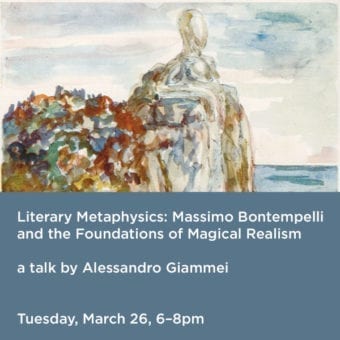
MEMBERS ONLY: TOUR OF HILMA AF KLINT: PAINTINGS FOR THE FUTURE AT THE GUGGENHEIM WITH CURATORIAL ASSISTANT DAVID HOROWITZ
March 19, 2019
“These paintings are a revelation, and like nothing that came before them” (The Economist)
CIMA is thrilled to invite its members this March to a private tour of the Guggenheim’s landmark exhibit Hilma af Klint: Paintings for the Future. We are fortunate to have the exhibit’s curatorial assistant David Horowitz leading the tour of what the New York Times has called a “staggering exhibition.” Although overlooked in her own time, af Klint’s experimentation in the first decade of the twentieth century has since been classified by art historians as the first true abstract art of the modernist period. Predating Kandinsky, Malevich and Mondrian’s modernist abstractions by nearly a decade, af Klint’s innovation and spiritual approach to painting was truly avant-garde in the sense of ‘before its time.’ Please join us for a private tour of her first major exhibition in the United States since 1986.
Please note: CIMA members will receive an email invitation in our newsletter, via Mailchimp to RSVP for this event. Due to the special nature of this private tour with one of the exhibit’s curators, the event is limited to 12 members only!
If you are feeling generous and you are able, please consider making a donation in person or here. As a public non-profit organization, CIMA works fervently to make such exclusive and exceptional events available to our members. Most of our members-only tours are free, but for this special and extravagant event, your financial support would be most welcome. Any amount will facilitate our ability to continue to offer our members access to one-of-a-kind private events at the premier art institutions across New York City.
Members receive free admission to CIMA, access outside of regular public hours, a copy of the annual catalogue, and invitations to exclusive events and receptions.
Photo Credit: Installation view of Hilma af Klint: Paintings for the Future, 2018. Photo: Scott Rudd © SRGF, NY.
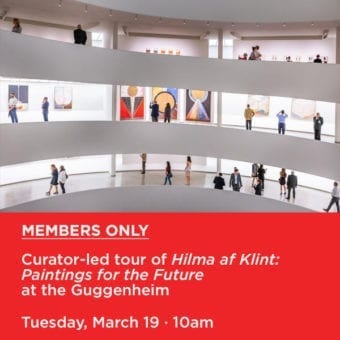
Sironi cupo: a lecture by Emily Braun
March 13, 2019
CIMA hosts Distinguished Professor Emily Braun for a special talk on Mario Sironi. She will address the themes of Sironi’s works on view in the current CIMA exhibition and in the context of the immediate postwar milieu in Italy (1918–1924), before the Fascist consolidation of power. The meaning of “cupo” (dark/ deep/ gloomy) a word often applied to Sironi’s style and person, will be used, instead, to interrogate the artist’s prolific representation of mannequins, mechanized protagonists, and automata in these years. Profoundly different from, if indebted to, the iconography of de Chirico’s metaphysical art, Sironi’s rendition of the dehumanized figure represents a wholesale break with past narrative traditions and anything but a “return to order.”
Emily Braun (Distinguished Professor, Hunter College and the Graduate Center, CUNY) is the author of Mario Sironi and Italian Modernism: Art and Politics under Fascism (Cambridge University Press 2000; Italian edition Bollati Boringhieri) and has published extensively on 20th century Italian art. In 2016 she organized Alberto Burri: The Trauma of Painting for the Solomon R. Guggenheim Museum, which was honored with the 2016 Dedalus Foundation Exhibition Catalogue Award. Most recently she has contributed essays to the catalogues of the Grant Wood retrospective at the Whitney Museum of American Art and the Lucio Fontana exhibition currently at the MET Breuer. She has been the recipient of Fellowships from the Getty Foundation and the New York Public Library Center for Scholars and Writers. Since 1987, Braun has curated the Leonard A. Lauder Cubist Collection and, in 2014, coauthored its catalogue for the Metropolitan Museum Art, which received the AAMC Award for Excellence.
Free for students and CIMA members.
RESERVE A SEAT!
Program schedule:
6pm – Registration, aperitivo, and viewing of Metaphysical Masterpieces
6:15pm – Program begins, followed by audience Q&A
8pm – Evening concludes
Refreshments have been generously donated by:
